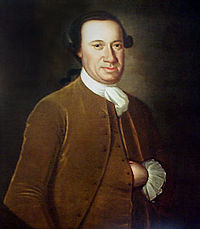In order to know, you have to take a nose dive into the political history of the United States. In the 1770's, while the Revolution was going on, much discussion was going on about what type of government the new country would have. The first proposal that had much weight was a government under the Articles of Confederation. The Articles of Confederation would allow states to have a great power, while maintaining a smaller, weaker centralized government. The colonies at the time feared a government that was too powerful, so they wanted a weak government. Many parts of the Articles were debated, so they were not official until 1781.
One common misconception about the Articles is that they believe that they created the United States of America, but they didn't. The colonies under the Articles were actually thirteen sovereign and independent states that were allied together. The closest modern comparison is NATO (the North Atlantic Treaty Organization) is an organization of nations, but there is no country called NATO. There was the smallest and weakest of a government between the colonies/states, but it had no power over the colonies/states. The Articles called for a Congress that was so limited in its powers that it couldn't enforce any of them, so they couldn't send troops to protect land from the British or Spanish in the West, nor could they raise money through taxes (all they could do was print more money, which led to inflation). In the end, many of the members of Congress stopped even going to sessions of Congress, which resulted in less than a quorum. It is without a doubt that the Articles were a failure, and by 1787, the government was out of money, so it transferred the debt from the Revolution to the states.
All this is important in the discussion of who the first President was because John Hanson was the first one elected to be in charge of this Congress as defined by the Articles of Confederation. However, it is important to know that he was only filling the position of President of the Continental Congress, not the country. The office of the Presidency (or the Executive Branch) was not established until the Constitution was drafted in the late 1780's. The first person selected for this position was George Washington, who ran unopposed, so he was unanimously elected.
 |
| John Hanson portrait from late 1760's |
So, in reality, George Washington was truly the first President of the United States. John Hanson was the first person who was the head of the Congress under the Articles of Confederation, but that was it. Hanson himself was an important member of the Continental Congress, but that was really about it. The notion that he was the first US President first came from Hanson's grandson, who went around promoting his grandfather as the real first US President. Because of this, Hanson has a statue in the US Capitol. In 1932, a biography of John Hanson was written by Seymour Wemyss Smith that claimed Hanson as being the first President also.
So, this one of the few times that I will say that to get the real story, you should just read your history book, and not an email. Some of the emails about Hanson say that he has been stripped from the history books, but in actuality, he just wasn't as important of a historical figure as anyone that is mentioned in history books. His role as the head of the Continental Congress was basically ceremonial, and if you factor in the difference between the Articles of Confederation and the Constitution, then it is clear that John Hanson was just someone who helped the Patriot cause, but in the end just wasn't the first President. That was George Washington.
Bet you didn't know that!
No comments:
Post a Comment